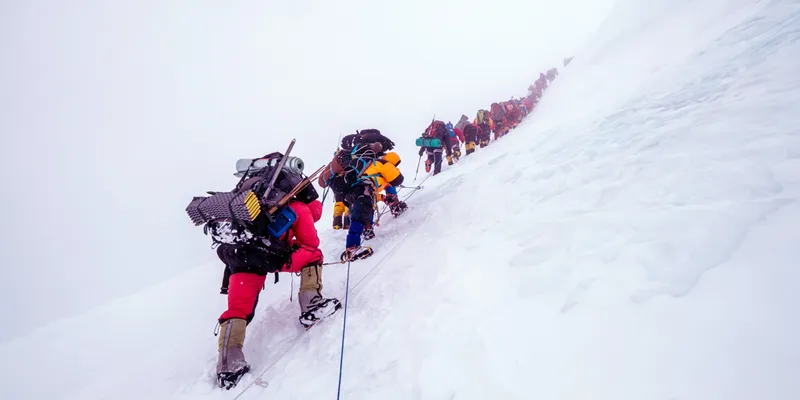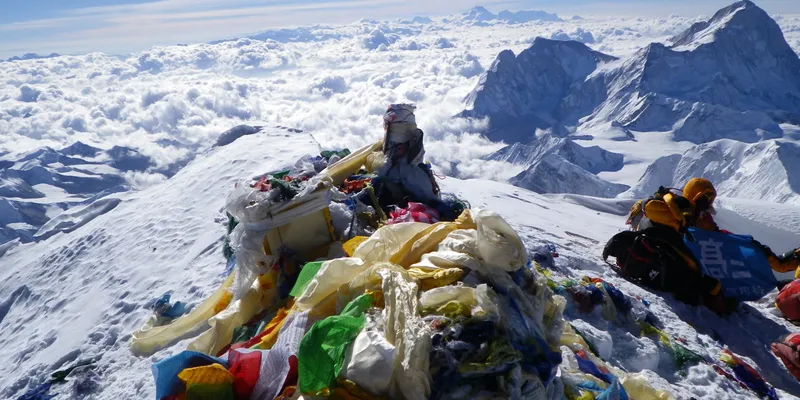Climbing Mt Everest or Mt Ego? The costly trail of personal achievement
Each year around 700 people attempt to climb Mt Everest, increasingly following the bandwagon of personal achievement. But at what cost? Everest is now polluted and overcrowded, and many have lost their lives not only to the brutality of nature but also to that of apathetic self-indulgence. Are we becoming as cold as the mountain?

Each year during April and May – months that show the kindest side of Mt. Everest – hordes of people mark the slopes of this mountain like a trail of ants. This isn’t an exaggeration as an average of 700 people queue up every year in a place that, six decades ago, hadn’t seen the likes of a human being. We sure have mastered the art of overpopulating, haven’t we?
When Sir Edmund Hillary and Tenzing Norgay conquered the peak in 1953, it was with the spirit of exploration and doing what no other human had ever done. What could be the incentive now, over 60 years later, when the peak has been trodden on innumerable times? For many mountaineers, who seek a sense of thrill, there are in fact other mountains that are more treacherous and challenging than Mt. Everest. But ask them, and they will tell you, there isn’t a trophy like the Everest. There can only be one highest peak, after all.
Everest is the glorious trophy that, only some years ago, belonged to the true mountaineers – people who spent their lives scaling mountains and climbing peaks. But if you zoom into the present, it is a trophy that sits on the mantle of just about anyone. Does this mean ‘ordinary’ people are not to attempt this feat? Not at all, as long as one is not barred by the Nepalese and the Chinese Government, anyone can take on the challenge; and that is where the problem begins.
Why do people climb?
Most people who make up that long queue are those who have very little or no experience in not only handling climbing gear but also handling themselves in an oxygen-deficient environment above 8,000m. Now, Everest is a mountain that likes to claim lives. There is an average of seven deaths each season, in the uneventful years. The year 2015 marked the most disastrous when an earthquake claimed 8,700 lives – at the base camp. It goes without saying that as one goes higher, the dangers only multiply. The year before that claimed the lives of 16 sherpas (not to be confused with Sherpas, the ethnic group) in the unsteady Khumbu Icefall, a trail that is open to climbers.
So, why do people climb?
Each climber carries with them a personal reason – anything from wanting to honour someone or raising money for charity to proving to themselves their endurance or going up against nature. To be able to say that one reached the highest summit in the world is without a doubt, a matter of pride. With EverestLink and China Mobile offering 4G internet, it is now easy for anyone to stream live feeds of this pride onto social media. In an age where selfies reign, it wouldn’t be surprising if most people are shelling out a minimum of $11,000 just for a selfie with the mighty Everest.

The problem of excess
The one thing that will not be found on the Everest today is solitude, which ironically has been the primary reason for an escape into the mountains. Norbu Tenzing, the son of Tenzing Norgay, told The Telegraph, “If he (Norgay) were alive he would be very sad to see how heavily trafficked and desecrated the mountain has become.”
But the overcrowding also happens to be the multimillion dollar industry that feeds an impoverished Nepalese economy. To put things in perspective, Nepal lost out on $60 million as tourist revenue when it was hit by the 7.8 magnitude earthquake in 2015. With an economy so heavily dependent on the profits this mountain attracts in just two months of the year, it is very clear that this is a situation that cannot be reversed.
Even with the government trying to discourage congestion by cutting down on group discounts, imposing age limits and a more stringent process for allowing permits, this matter seems to be entirely in the hands of the people. It has been observed that the years following the highest death tolls have had the most number of climbers. Now, the conclusion to be drawn from this is best left to social psychologists but the possibility of death, far from discouraging people, seems to be morbidly inviting them.
The dirty trail
This need for personal achievement, which even death can’t seem to shake, seems to be bringing out the worst in people. In their fervour to reach the summit, there have been many that have walked past injured climbers who have died as a result. In 2006, about 40 climbers walked past David Sharp, a British climber who was extremely frostbitten and unable to move and who later froze to death. An Israeli climber, on the other hand, stopped his ascent to carry an injured stranger on his back for nine hours, thereby rendering moot, the explanation of “there was nothing that could be done,” which is what most have used to justify their apathy.
Compassion also goes amiss when sherpas are expected to carry luxury tents and coffee machines along with the heavy load of necessities.
Then, there is the literal dirty trail that people are leaving behind. According to Grinnell College, about 26,500 pounds of human excreta is generated each season, which is carried and dumped by the sherpas at the village of Gork Shep. This village has been serving as the sewage dump of the Everest and has now, unsurprisingly, reached its limit. Adding to this pollution is the garbage leftover at higher altitudes. Sherpas trek to the ‘death zone’, which is 26,000 ft above sea level, to clean up trash collected over decades. Many have even lost their lives in the process.

To manage this issue of mounting garbage, the Nepalese government, in 2014, imposed a deposit of $4,000 at the commencement of the expedition, which would be returned only if the group returned with 18 pounds of trash. This, unfortunately, hasn’t been implemented strictly and so, the trash continues to soil the face of this majestic mountain.
The fact of the matter is people will continue to horde the mountain, whatever their reasons for it may be; and as Norbu Tenzing says, “If people want to climb Everest or any mountain, I would say absolutely.” But maybe there is a way to do it responsibly, by being aware of the intentions behind and consequences of our actions. The mountain will always beckon, but the question is, are we going to exploit its welcome?







